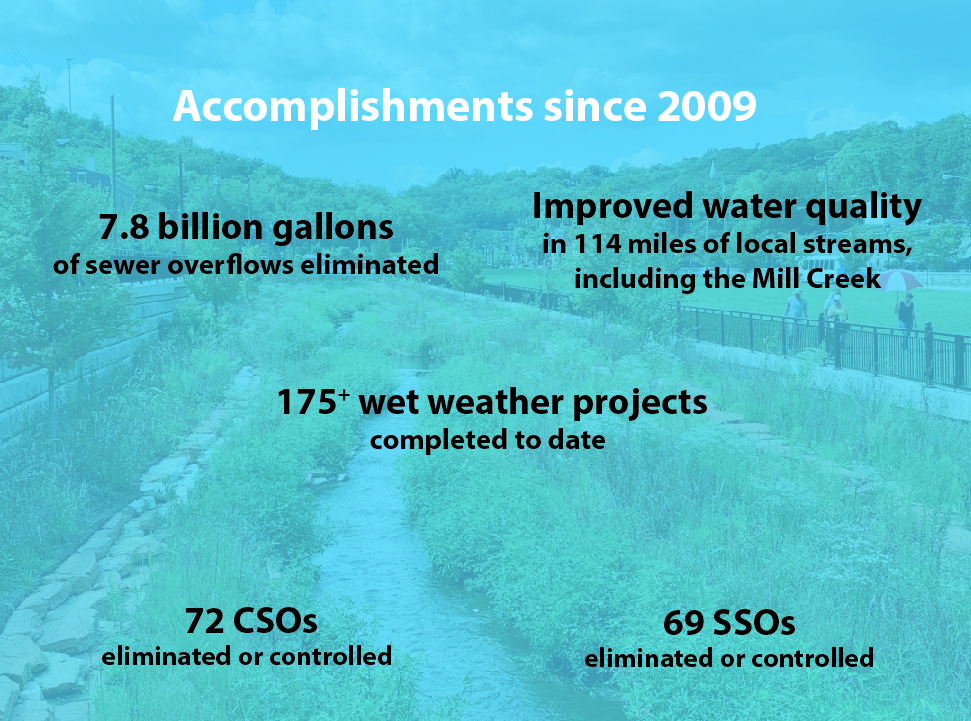Progress
MSD has been working for more than a decade to reduce combined sewer overflows (CSOs) and eliminate sanitary sewer overflows (SSOs) into our local rivers and streams. To date, we have reduced CSOs by about 8 billion gallons annually (from 14 billion to 6 billion gallons a year during a typical year of rain) and made significant improvements in eliminating SSOs.
We completed the first phase (Phase 1) of our Wet Weather Program in 2021, have nearly completed a series of wet weather projects known as the Bridge Plan, are working to complete another phase (Phase 2A) by the end of 2024, and will soon be negotiating with the U.S. EPA on the next set of wet weather projects (Phase 2B).
In addition, MSD has operated a Sewer Backup (SBU) Program for MSD customers since 2004 to help mitigate the impacts of sewer backups caused by the public sewer.

CONSENT DECREE REPORTS
For detailed information on MSD's Wet Weather Program, including budget, schedule, performance metrics, potential project risks, etc., please view or download the reports below:
Consent Decree Quarterly Reports (select a report from the list below). Please see the appendices for specific information about Phase 1, the Bridge, and Phase 2A.
Consent Decree Annual Reports (select a report from the list below):
Other Reports and Plans (select a report from the list below):
CURRENT STATUS OF MSD CAPITAL PROJECTS
This database is a list of active MSD capital projects in planning, design, construction, final acceptance, or closeout under our Capital Improvement Program (CIP). This database is updated monthly.
You can sort (ascending/descending) each column of the database by clicking the small triangle underneath each header.
SBU PROGRAM
The SBU program offers 24/7 reporting of sewer backups, investigation of sewer backups to determine whether they were caused by the MSD public sewer, cleaning services for eligible properties, reimbursement of damages for eligible properties, and protection from future sewer backups for eligible properties.
MSD issues a monthly program report that provides information on the number of sewer backup reports received each month, the number of properties served by the program, and dollars spent.
VIEW SBU PROGRAM REPORT (UPDATED MONTHLY)
PHASE 1 (2009 - 2021)
During Phase 1, MSD completed about 150 wet weather projects at a cost of about $961 million (in 2006 dollars) and $1.08 billion in 2024 dollars. The estimated cost of Phase 1 was $1.14 billion (in 2006 dollars), so this phase came in under budget. These projects, representing Consent Decree indices 1-119, ranged from sewer replacements to sewer separations and pump station eliminations to treatment plant upgrades. The largest project was the Lower Mill Creek Partial Remedy (LMCPR) which included 24 separate wet weather projects to reduce CSOs into the lower portion of the Mill Creek. The Lick Run Greenway in South Fairmount (internally listed as the Lick Run Valley Conveyance System) was the largest of these projects.
LIST OF PHASE 1 PROJECTS AND COST SUMMARY (INDICES 1-119)
BRIDGE PLAN (2018-2024)
The Bridge Plan is an interim phase of 20 wet weather projects between the end of Phase 1 and the beginning of Phase 2A. MSD has completed 18 of the 20 projects as of spring 2024. The two remaining projects are expected to be completed by summer 2024.
The status of the Bridge Plan can be found in the Consent Decree Quarterly Reports (found on this page) under Appendix A (Bridge).
PHASE 2A (2023-2024)
Phase 2A was approved in August 2023 and includes the construction of three projects by the end of 2024: the Mill Creek WWTP Diversion Chamber (already completed), CSO 402-406 Regulators Improvements in Sayler Park (underway), and the Little Miami WWTP Standby Power project (underway).
It also includes design of two projects, a new influent pump station at the Mill Creek WWTP to serve a future enhanced high-rate treatment (EHRT) facility and planning for improvements to the East Branch Muddy Creek Interceptor and associated pump stations, which brings flows to the Muddy Creek plant in Sayler Park.
The status of Phase 2A can be found in the Consent Decree Quarterly Reports (found on this page) under Appendix A (Phase 2A).
OVERFLOW OCCURRENCES
MSD reviews hundreds of monitored overflow points to confirm actual overflow occurrences at each outfall. This database includes all discharges, including CSOs, SSOs, and Non-Enumerated Overflows (NEOs), since November 2016 and all CSO discharges since 2010.
Click on a specific outfall to learn more or adjust the date range to narrow your search.
CSO VOLUMES
MSD reports all discharges from CSOs in its monthly Discharge Monitoring Reports submitted to the Ohio EPA. Since November 2023, MSD has used advanced data analysis tools to measure and categorize daily overflow volumes when the sewer system is under various conditions, such as: dry weather, wet weather, and flooded conditions.
Use the data filters to find information on specific CSOs.
Map Legend:
- WW OF: Wet Weather overflow volume reported within 24 hours of recorded rainfall in the contributing sewershed.
- DW OF: Dry Weather overflow volume reported with no recorded rainfall in the contributing sewershed.
- FL OF:Flooded overflow volume reported when local creek or river level is elevated and influencing the combined sewer system.
- AVAILABLE (%): Percentage of time that remote monitoring equipment was in service and reporting.